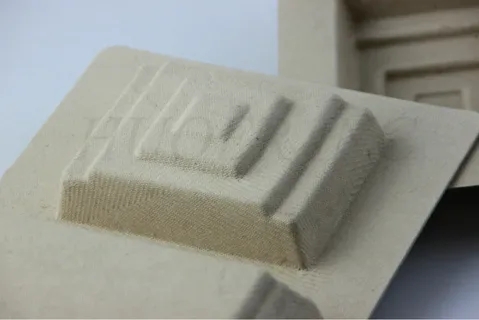Best QA Techniques to Improve Molded Pulp Quality Control
During this stage, manufacturers should employ a combination of manual and automated measuring tools to detect dimensional defects.

Quality Assurance (QA) plays a crucial role in ensuring the consistent performance of molded pulp products. As demand for eco-friendly packaging increases, ensuring the quality of molded pulp—made from renewable materials like recycled paper and plant fibers—has become essential. Quality control of molded pulp involves the careful monitoring of every stage of production, from raw material selection to the final product. This article explores the best QA techniques that can be applied to improve molded pulp quality control, ensuring the production of high-quality, sustainable products.
Establishing Strong Raw Material Inspection Protocols
The first step in QA for molded pulp is ensuring that the raw materials meet the required standards. Raw material quality directly impacts the final product's strength, texture, and durability. Paper fibers, which are the most common component, must be free of contaminants like ink, plastic, or non-paper materials, which can weaken the pulp and compromise the molded item’s quality. A robust raw material inspection protocol ensures that any material entering the production process is of the highest quality.
QA teams should implement rigorous testing of raw materials, such as tensile strength tests for paper fibers and checking for moisture content, to ensure the material is suitable for molding. Additionally, suppliers should be regularly audited to confirm that they adhere to the required specifications. This step is crucial in preventing issues during the production phase, such as uneven molding or weak structural integrity of the final product. By establishing these protocols, manufacturers can ensure a consistent raw material supply that meets the standards for molded pulp production.
Automated and Manual Monitoring of the Molding Process
Once the raw materials are prepared, the next critical stage of QA for molded pulp is monitoring the molding process itself. Automated systems, such as sensors and cameras, can continuously monitor parameters like pressure, temperature, and humidity during molding. These factors significantly affect the final product's quality. Automated systems allow for precise control over these conditions, ensuring uniformity and preventing defects such as cracks or inconsistencies.
In addition to automated monitoring, manual checks should be incorporated. Operators should be trained to spot issues that might not be immediately apparent through automated systems, such as small irregularities in texture or structure that could affect product performance. By combining both automated and manual quality control measures, manufacturers can achieve the best results, ensuring that the molded pulp products meet the desired specifications, such as strength, smoothness, and durability.
Implementing Consistent Product Testing and Validation
Regular product testing and validation are integral to QA for molded pulp, ensuring that the products meet customer expectations and industry standards. These tests should be performed at various stages of production, from testing individual molds to inspecting finished products. Key quality indicators, such as compressive strength, resistance to moisture, and the ability to retain shape under stress, must be evaluated regularly.
Test results should be meticulously documented to track trends and identify potential production issues. Validation processes must include comparison with set quality benchmarks, helping manufacturers determine whether their products meet required standards. If the products do not pass these tests, corrective actions can be taken immediately, such as adjusting the molding process or altering the raw material composition. Consistent testing is an essential technique in the QA process, ensuring that the final products meet both regulatory and consumer standards.
Post-Molding Inspection for Dimensional Accuracy
Dimensional accuracy is crucial when it comes to molded pulp products, especially those used in packaging or custom molds. After the molding process, each item should be inspected for size, shape, and uniformity. A well-designed post-molding inspection system will check whether the product meets the specified dimensions within an acceptable tolerance range. This helps ensure that products fit into their intended applications, such as packaging components or consumer products.
During this stage, manufacturers should employ a combination of manual and automated measuring tools to detect dimensional defects. Tools like calipers and laser measuring systems can provide precise measurements, allowing for quick identification of products that are out of specification. Early detection of dimensional issues ensures that defective products are removed from the production line before they reach the customer, thus reducing waste and improving overall production efficiency.
Continuous Improvement and Feedback Loops
A successful QA strategy for molded pulp goes beyond simply identifying defects—it also incorporates a feedback loop that fosters continuous improvement. By gathering data from every stage of the production process and post-production testing, manufacturers can analyze trends, identify root causes of defects, and implement corrective actions. This approach ensures that quality issues are not just addressed on a case-by-case basis but are systematically eliminated through process adjustments.
Regular audits, employee training, and updating QA protocols are all part of maintaining and improving product quality over time. A culture of continuous improvement ensures that molded pulp manufacturers remain competitive, reduce waste, and consistently produce high-quality, eco-friendly products. By using customer feedback and industry insights, manufacturers can adjust their processes to meet changing demands and enhance their molded pulp products' performance, reliability, and sustainability.
Conclusion
Incorporating best QA techniques for molded pulp is essential to ensure high-quality, sustainable products in today’s eco-conscious market. Through meticulous raw material inspection, automated and manual monitoring during the molding process, consistent product testing, post-molding inspections, and continuous improvement strategies, manufacturers can significantly improve their molded pulp quality control. With these measures in place, they can deliver products that not only meet industry standards but also exceed consumer expectations, contributing to the growing demand for eco-friendly packaging solutions and molded pulp products.
What's Your Reaction?






















